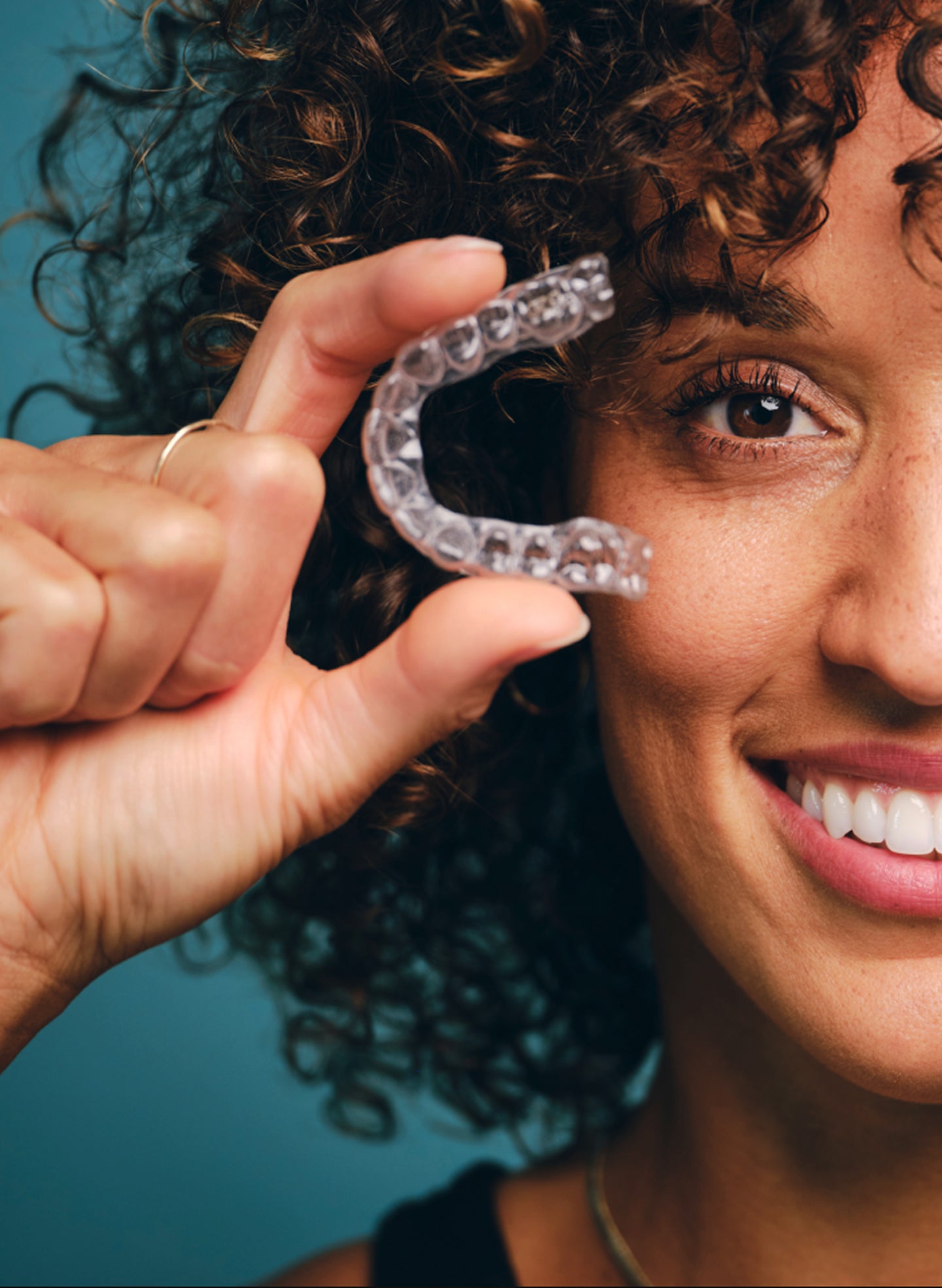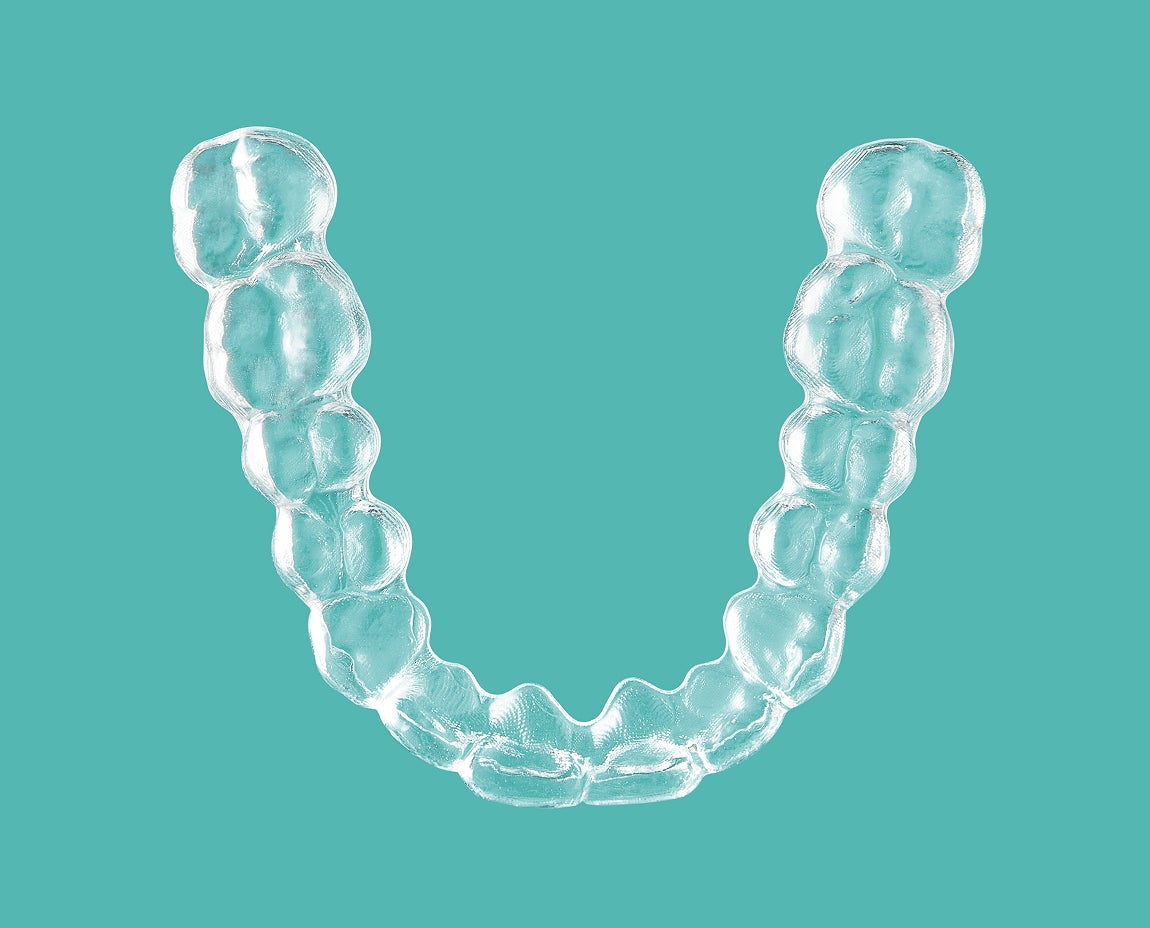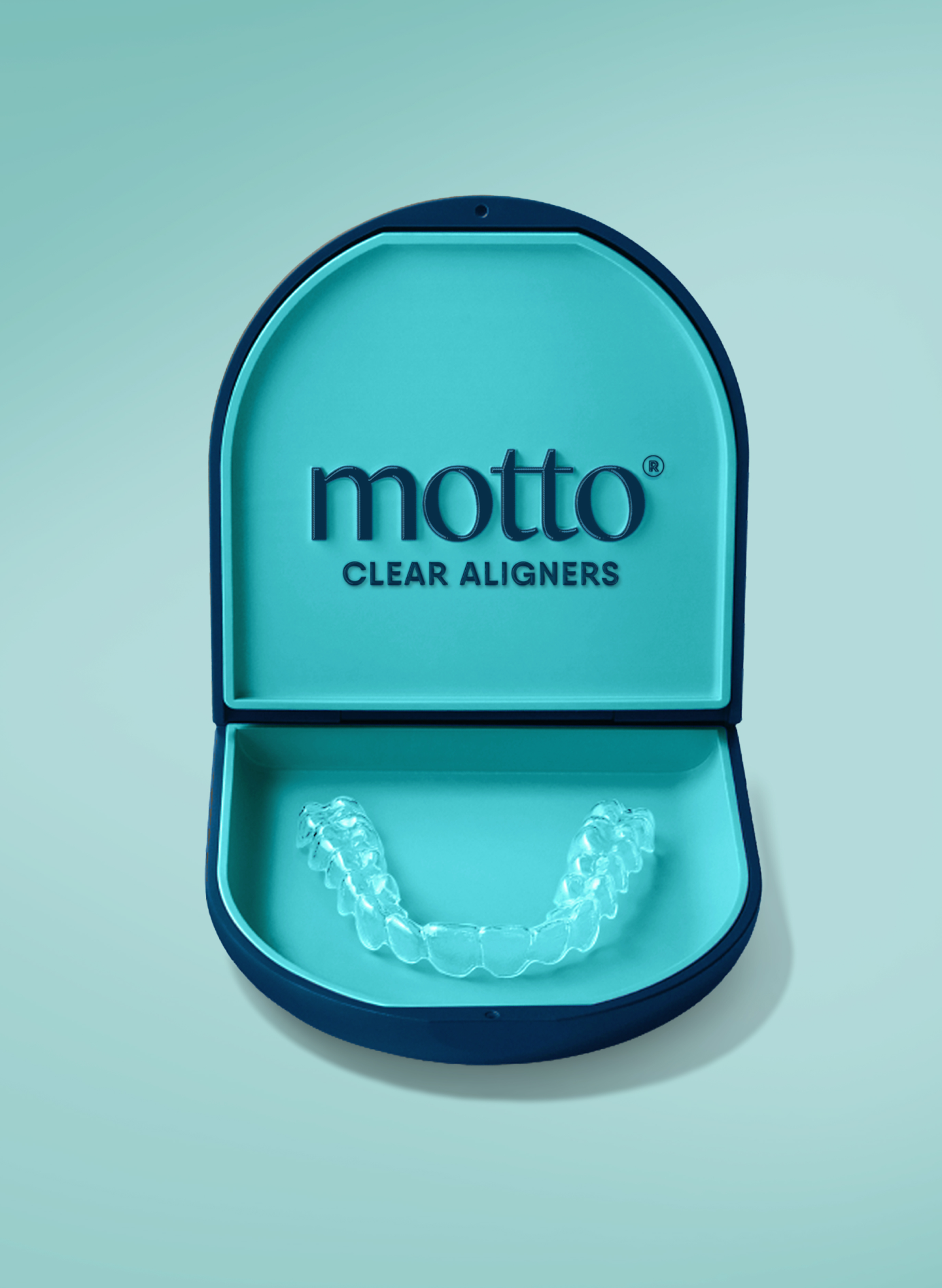Last updated 05.19.2025
What is Invisalign®? (A Complete Guide to Clear Aligners)
Explore how Invisalign works and compare it to Motto clear aligners on price, care, and treatment process.

Invisalign has transformed orthodontic treatment by providing a nearly invisible alternative to traditional metal braces. If you're exploring teeth straightening options, gaining an understanding of what Invisalign is and how it works can empower you to make an informed decision about your dental health.

Exploring Your Clear Aligner Options
While Invisalign pioneered the clear aligner industry, today's patients have more choices than ever. If you're researching clear aligner options, consider Motto® clear aligners as an alternative solution.
Why Consider Motto Clear Aligners?
Motto clear aligners offer several distinct advantages:
Personalized treatment: Designed with advanced AI technology to create highly-customized treatment plans
Comfort-focused design: Engineered with smooth edges and precise contours for enhanced comfort
Competitive pricing: Often more affordable than Invisalign with comparable results
Cutting-edge materials: Utilizes the latest in clear aligner technology for optimal tooth movement
Many patients find that Motto clear aligners provide the perfect balance of effectiveness, comfort, and value. During your teeth straightening consultation, ask your provider about Motto Clear Aligners to determine if they might be the right solution for your smile transformation journey.
Want to see if you’re a candidate for straightening? Take our quiz to find out.
Invisalign is a brand of clear aligners — transparent, removable orthodontic devices designed to straighten teeth without the use of traditional metal brackets and wires. Developed by Align Technology in the late 1990s, Invisalign has become one of the most recognized names in contemporary orthodontic treatment. While Motto clear aligners are the primary option at Aspen Dental, select locations also offer Invisalign as a treatment option. To explore your options, find an Aspen Dental location near you.
Looking for an affordable solution to straightening? Read how Motto clear aligners makes it easy to achieve your dream smile within you budget.
Understanding Invisalign: What It Is & How It Works
What is Invisalign made of?
Invisalign aligners are crafted from a patented thermoplastic material known as SmartTrack®. This FDA-approved, medical-grade plastic is:
BPA-free, containing no BPA, BPS, latex, or gluten
Thin and transparent, making the aligners nearly invisible
Custom-molded to fit precisely over your teeth
Designed to apply controlled force to specific teeth at specific times
The material was specifically engineered to provide predictable, controlled tooth movement while maximizing comfort during the teeth straightening.
Learn what makes Motto’s next generation aligners different than other brands.
How does Invisalign straighten teeth?
Invisalign works on the same fundamental principle as traditional braces: applying consistent pressure to move teeth into proper alignment gradually. However, the approach differs significantly:
Digital planning: Treatment begins with a 3D digital scan of your teeth, which creates a precise map of your current tooth positions.
Custom sequence: Your dentist or orthodontist creates a customized treatment plan using specialized software that maps out the exact movements of your teeth through each stage.
Graduated pressure: Each set of aligners in your series slightly adjusts tooth position, typically moving teeth 0.25 to 0.3 millimeters per aligner.
Progressive replacement: You'll change to new aligner trays approximately every 1-2 weeks as your teeth gradually shift into their prescribed positions.
Unlike traditional braces, which pull teeth into alignment using tension on wires, Invisalign uses custom-shaped trays to push teeth into position through precisely applied force.
What is Invisalign used for?
Invisalign can address many of the same orthodontic issues as traditional braces, including:
Crowded teeth: When there isn't enough room in the jaw for all teeth to fit normally
Spacing issues: Gaps or abnormal spacing between teeth
Overbite: When upper front teeth overlap significantly with the lower front teeth
Underbite: When lower teeth protrude past upper front teeth
Crossbite: When upper and lower jaws don't align properly
Open bite: This occurs when the upper and lower teeth do not make contact when the mouth is closed.
While Invisalign can address many common orthodontic issues, severe misalignments may require traditional braces or other interventions.
Who is a good candidate for Invisalign?
Invisalign is typically suitable for:
Teens and adults: The treatment is approved for patients with permanent dentition (all adult teeth), usually aged 12 and older.
Disciplined wearers: Since aligners are removable, treatment success depends on wearing them for 20-22 hours daily.
Non-smokers: Smoking can stain the aligners and compromise oral health.
People with mild to moderate alignment issues: While Invisalign technology advances, complex cases may require different treatment approaches.
Your dentist or orthodontist will assess your situation to decide if Invisalign is suitable for your needs or if others might be more beneficial for you.

The Invisalign Treatment Process
(Step-by-Step)
Understanding the complete Invisalign journey from consultation to completion can help you know what to expect throughout the process.
How does Invisalign treatment start?
The Invisalign treatment process begins with:
Initial consultation: Your dentist or orthodontist will examine your teeth, discuss your goals, and determine if Invisalign is right for you.
Digital scanning: Instead of traditional putty impressions, most providers use an iTero® digital scanner to create a precise 3D model of your teeth and gums.
Treatment planning: Using Invisalign's ClinCheck® software, your provider creates a detailed treatment plan showing the projected movement of your teeth from start to finish.
Preview of results: Many providers can show you a virtual representation of how your teeth will look after treatment.
Custom aligner creation: Once you approve the treatment plan, Align Technology manufactures your custom series of aligners based on your provider's specifications.
The planning typically takes 2-4 weeks from initial consultation to receiving your first set of aligners.
What happens during Invisalign checkups?
Throughout your Invisalign treatment, you'll have periodic checkups with your provider:
Frequency: Typically every 6-8 weeks, though this varies by provider and individual case
Purpose: To monitor progress, adjust if needed, and provide new sets of aligners
Duration: Appointments are usually brief (15-30 minutes) compared to wire-adjustment appointments for traditional braces
Assessments: Your provider will check that teeth are moving as planned and that you're wearing your aligners properly
These appointments are crucial for ensuring your treatment progresses correctly and efficiently.
How long does Invisalign treatment take?
Treatment duration varies based on the complexity of your case and how consistently you wear your aligners:
Average treatment times:
Simple cases: 6-12 months
Moderate cases: 12-18 months
Complex cases: 18-24 months
Factors that influence treatment length include:
Severity of misalignment
Distance teeth need to move
Compliance with the 20-22 hour daily wear recommendation
Age (teeth tend to move faster in younger patients)
Some providers offer accelerated treatment options that can be used with Invisalign to reduce treatment time.
Does Invisalign hurt?
Most patients experience some discomfort with Invisalign, but it's typically described as pressure rather than pain:
Initial discomfort: When starting with a new set of aligners, you may feel pressure for the first 2-3 days
Adjustment period: This pressure indicates the aligners are working to move your teeth
Comparison to braces: Most patients report Invisalign is less painful than traditional braces
Management: Over-the-counter pain relievers like acetaminophen or ibuprofen can help with any discomfort
Invisalign is designed with comfort in mind, with no metal brackets or wires to irritate cheeks and gums.
How does Invisalign compare to traditional braces?
Both treatment options have proven effective, and the best choice depends on your specific needs, lifestyle, and preferences. Many practices now offer complimentary orthodontic consultations to help determine the ideal treatment approach.
Invisalign Cost, Maintenance & Aftercare
Understanding the financial investment and care requirements helps ensure a successful Invisalign experience.
How much does Invisalign cost?
The cost of Invisalign treatment varies based on several factors:
National average cost range: $3,000 to $8,000
Treatment complexity: More complex cases requiring longer treatment time cost more
Geographic location: Prices vary by region and local market rates
Provider experience: Orthodontists with more Invisalign experience may charge more than general dentists or less experienced providers
Additional procedures: Preliminary dental work, refinements, or retainers may add to the total cost
Many providers offer payment plans, and some dental schools provide discounted orthodontic treatment supervised by experienced faculty.
Does insurance cover Invisalign?
Insurance coverage for Invisalign varies widely:
Orthodontic benefits: If your dental insurance includes orthodontic benefits, Invisalign is typically covered similarly to traditional braces
Coverage limitations: Many plans cover 25%-50% of the treatment cost up to a lifetime maximum (often $1,000-$2,000)
Age restrictions: Some plans only cover orthodontic treatment for patients under 18
Pre-authorization: Many insurance companies require pre-treatment authorization
Additional payment options include:
Health Savings Accounts (HSAs) or Flexible Spending Accounts (FSAs)
Dental discount plans
Third-party financing such as CareCredit or LendingClub
In-house payment plans offered by providers
Always check with your insurance provider and orthodontist to understand coverage before beginning treatment.
How to clean and maintain Invisalign aligners
Proper maintenance of your Invisalign aligners is essential for hygiene and keeping them virtually invisible:
Daily cleaning routine:
Rinse aligners with lukewarm water whenever you remove them
Brush aligners gently with a soft toothbrush twice daily
Use clear, unscented antibacterial soap or Invisalign cleaning crystals
Rinse thoroughly before placing back in mouth
What to avoid:
Hot water (can warp the plastic)
Toothpaste (too abrasive)
Colored or scented soaps (can stain or leave a taste)
Soaking in mouthwash (can discolor aligners)
Eating or drinking anything besides water while wearing aligners
Following proper aligner care instructions helps maintain their clarity and effectiveness throughout treatment.
What happens after Invisalign treatment? (Retainers & Follow-Ups)
Completing your Invisalign treatment isn't the end of your orthodontic journey:
Retainer fitting: Most providers prescribe retainers to maintain your new smile
Retainer types:
Vivera® retainers (made by Align Technology)
Clear plastic retainers similar to Invisalign
Traditional wire retainers bonded to the back of teeth
Wearing schedule:
Initially: Full-time wear for 3-6 months
Long-term: Nighttime wear indefinitely
Follow-up appointments: Periodic checks to ensure teeth remain in position
Retainer replacement: Typically needed every 1-3 years, depending on wear
The retention phase is crucial—without consistent retainer use, teeth can shift back toward their original positions, potentially undoing your Invisalign results.
Frequently Asked Questions (FAQs) About Invisalign
Is Invisalign better than braces?
Rather than one being "better" than the other, Invisalign and traditional braces each have situations where they excel:
Invisalign may be preferable when:
Aesthetics are a primary concern
You want the ability to remove your orthodontic appliance
Your case is mild to moderate in complexity
Oral hygiene is a significant concern
Traditional braces may be preferable when:
Your case involves complex tooth movements or severe misalignment
You might struggle with the discipline to wear removable aligners
Cost is a limiting factor
You prefer not having the responsibility of removable appliances
The "better" option is the one that best addresses your specific orthodontic needs while aligning with your lifestyle and preferences.
How visible are Invisalign aligners?
Invisalign aligners are designed to be as unnoticeable as possible:
From a conversational distance (3+ feet), they're typically not visible
Up close, someone may notice a slight shine on the teeth
Attachments (small tooth-colored bumps that help with complex movements) can make the treatment slightly more noticeable
Most patients report that others rarely notice they're wearing aligners unless told
Photography and specific lighting can sometimes make aligners more visible
Many patients find that even if people notice their aligners, the aesthetic improvement over metal braces is significant enough to make Invisalign the preferred option.
Can I eat and drink while wearing Invisalign?
The general rule is to remove your aligners for eating and drinking anything other than water:
Water: Fine to drink with aligners in
All foods: Remove aligners
Non-water beverages: Remove aligners (including coffee, tea, juice, soda, and alcohol)
Why removal is necessary:
a. Hot beverages can warp the plastic
b. Colored drinks can stain aligners
c. Sugar trapped between aligners and teeth can increase cavity risk
d. Chewing with aligners can damage them
If you must drink something besides water while wearing aligners, using a straw can help minimize contact, followed by rinsing as soon as possible.
How often do I need to wear Invisalign aligners?
For optimal results, Invisalign aligners should be worn:
20-22 hours per day
Only removed for:
Eating and drinking (except water)
Brushing and flossing
Special occasions (briefly)
Consistent wear is crucial for treatment success. Insufficient wear time can:
Extend overall treatment duration
Cause aligners to fit improperly
Result in teeth not tracking according to plan
Potentially require backtracking to previous aligners
Most providers now use compliance indicators or monitoring apps to help patients keep to the recommended time for wearing their aligners.
What happens if I lose an Invisalign tray?
If you lose or break an aligner:
1. Contact your provider immediately for guidance specific to your situation
2. Typical solutions:
If you're nearly ready for your next set (within 1-2 days), your provider may have you move forward
If you're mid-cycle, they might recommend wearing your previous aligner until a replacement arrives
In some cases, a replacement aligner can be ordered
3. Prevention tips:
Always store aligners in their case when not in the mouth
Avoid wrapping aligners in napkins (common cause of accidental disposal)
Keep previous sets of aligners as backups
Many providers include one or two replacement aligners in the treatment cost, but additional replacements may incur fees, typically ranging from $50 to $200 per aligner.
If you’re looking to find out if Invisalign is suitable for your teeth straightening needs, think about scheduling a consultation with a certified orthodontist. The orthodontist can assess your unique situation and go over all the treatment options available to you.





